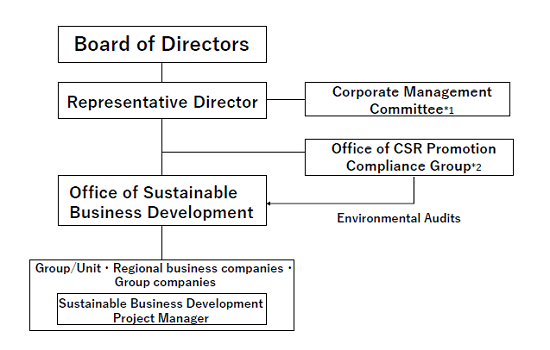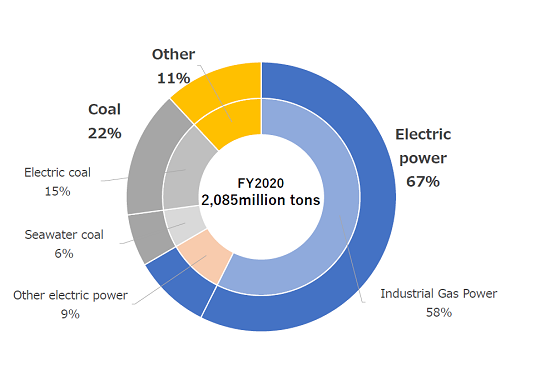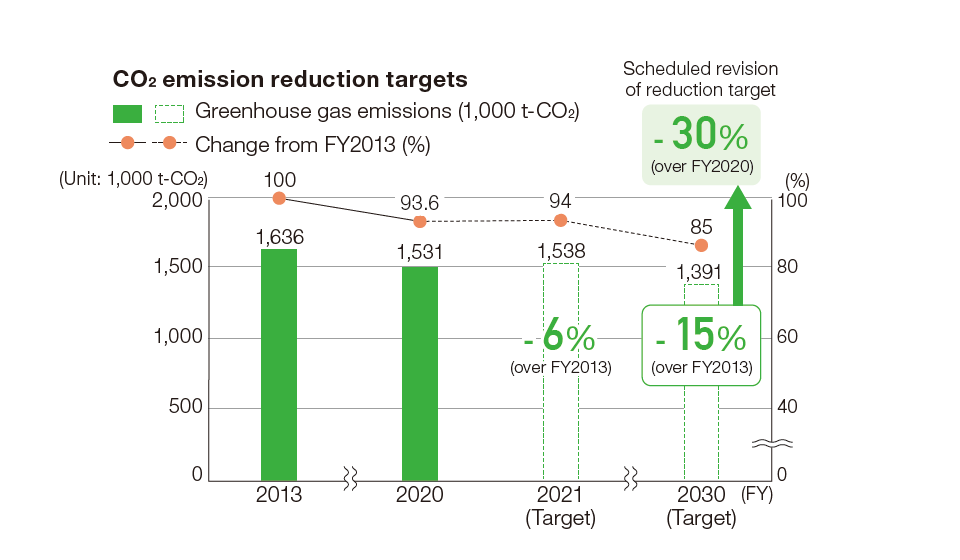In August 2021, the Air Water Group expressed support for the recommendation of the Task Force on Climate-related Financial Disclosures (TCFD), which had been founded by the Financial Stability Board (FSB), and joined the TCFD Consortium. The TCFD recommendations request that information be disclosed about climate change-related governance, strategies, risk management, and metrics and targets. In line with the recommendations, the Air Water Group disclosed relevant information in March 2022.
Our Group, which views climate change actions as one of the important management issues, has the SDGs Promotion Office operating under the responsibility of dedicated staff as a climate change supervisory office. In addition to designing and implementing our Group’s climate change actions, the office promotes efforts to combat climate change in-house and checks their progress. We have a system in place in which the companies and group companies hold their SDGs business promotion staff responsible for examining and assessing climate change-related risks and opportunities so that they can reflect climate change-related viewpoints in their business strategies and promotion.
Climate change-related basic policies and important matters, which are subject to the supreme management committee, the decision-making body for management execution, are annually reported to the board of directors and reflected in the board’s decisions on basic policies so that the board’s supervision works appropriately.

*1 The Corporate Management Comittee, chaired by the Chairman and CEO, is the decision-making body for the Group's wide range of businesses and is composed of internal directors and managers of each business unit. The committee meets once a month to discuss and decide important matters related to the execution of the Group's business operations and to deliberate on matters before the Board of Directors.
*2 The Office of CSR Promotion Compliance Group manages environmental compliance risks for the Group by providing guidance and education on compliance with environmental laws through environmental audits.
Viewing the realization of a carbon-neutral society as one of the important themes, we had each business division design the roadmap up to fiscal 2030 as a medium-to long-term strategy for realizing carbon neutrality by 2050. With effects of climate change-related risks and opportunities identified by each division of our business taken into account, we are going to reduce greenhouse gas emissions through our supply chains and create and promote products and services contributing to a reduction in greenhouse gas emissions in society.
In order to examine medium-to long-term (*3) climate change-related risks and opportunities with a focus on 2030, we focused on 7 business segments and discussed how to address matters of high importance.
Major transitional risks influential on financial affairs and business in the future include increased operational cost due to increased environmental tax or the introduction of carbon tax. Its introduction would increase our Group’s annual costs by approximately 29 billion yen as a direct effect on us, assuming our entire Group’s greenhouse gas emissions for 2030 remained unchanged compared to fiscal 2020 (approx. 2.09 million tons / year) with a carbon price set at 13,800 yen / t-CO\( \sf _2 \) on the basis of the predictions of IEA (*4) and of SDS (*5). But with our goal of achieving a 30% reduction in CO\( \sf _2 \) emissions compared to fiscal 2020 met in 2030, our annual cost increase due to the carbon price would be reduced to approx. 20 billion yen.
Physical risks include worsening of extreme weather causing increased damage risks to manufacturing hubs, and operational shutdown leading to the loss of sales opportunities or traffic interruption accompanied by logistics disruption, leading to increased logistics costs and the loss of sales opportunities. Physical risks are incorporated into the risk management system of the company-wide business continuity plan (BCP), to be managed continuously.
As climate change-related research and development investment, we are creating products and services responsive to climate change-related market needs and social issues with a focus on the development of technology to recover CO\( \sf _2 \) from exhaust gas, and bio green technology such as waste-based methanation.
*3 Medium term: 1 to 3 years; long term: 3 years or longer
*4 International Energy Agency
*5 Sustainable Development Scenario
|
Transitional risks |
|
|---|
|
Physical risks |
|
|---|
|
Opportunities and responses |
■ Achieving a 30% reduction in CO\( \sf _2 \) emissions compared to fiscal 2020 by fiscal 2030 |
|---|
Our Group clarified risks and opportunities surrounding a difficult-to-predict and uncertain event, climate change, and undertook a scenario analysis to investigate the effects its risks and opportunities will have on our Group. The scenario analysis was performed with a focus on the industrial gases business and the agriculture & food products business (beverage business), both of which stand out in business scale in our wide range of business fields and seem significantly prone to climate change-related risks. The analysis used the global average temperature rise 4℃ scenario and the 1.5℃ and 2℃ scenarios.
The 1.5℃ and 2℃ scenarios examined mainly the transitional risks surrounding societal changes in the process of technological innovation or tighter regulations for the prevention of warming, while the 4℃ scenario was focused on physical risks in the situation where extreme weather worsens without appropriate measures against warming. The 1.5℃ and 2℃ scenarios referred to IEA NZE (*6) and SDS, IPCC (*7) SR15 (*8) and RCP (*9)2.6, among other sources, while the 4℃ scenario referred to IEA STEPS (*10) and IPCC RCP8.5, among other sources, and both scenarios are based on global perspective as of 2030. The average temperature rise in the physical risk is discussed from the standpoint of 2050.
We considered climate change-related risks derived largely from average temperature rise, as the industrial gas-related business is significantly prone to carbon tax while in the agriculture and food industry (the beverage business), yield decrease or the relocation of a production area due to climate change-related poor harvests or poor-quality finished products in the place of origin likely has a huge impact on stable procurement of raw materials.
These risks can be curbed through a decrease in greenhouse gas emissions by energy saving or renewable energy or the diversification of raw material suppliers. While existing supply chains possibly face a significant change due to increased energy cost or restrictions on plastics, we believe that such risks can be addressed through such efforts as energy saving and renewable energy or the adoption of containers made of recycled materials, biomass, or Forest Stewardship Council (FSC)-certified paper, among other materials, even anticipating an increase in sales opportunities.
While the result of the scenario analysis shows us that the 1.5℃ and 2℃ scenarios can create more business opportunities, we believe that even with the 4℃ scenario, we can prepare appropriate actions in addition to acquiring and increasing opportunities and have enough resilience to respond to a long-term uncertain future.
*6 Net-Zero Emissions by 2050 Scenario
*7 Intergovernmental Panel on Climate Change
*8 Special Report on Global Warming of 1.5℃
*9 Representative Concentration Pathways Scenario
*10 Stated Policies Scenario
|
<1.5℃ / 2℃ scenario> |
Details of risks, opportunities (★) and responses (■) |
|---|
|
Risks |
|
|
Opportunities and responses |
■ Investment in energy-saving equipment such as a highly efficient gas manufacturing plant |
|
<4℃ scenario> |
Details of risks, opportunities (★) and responses (■) |
|---|
|
Risks |
|
|
Opportunities and responses |
■ Investment in energy-saving equipment in a high-efficiency gas manufacturing plant and shift in the cooling system from use of water cooling to air, in areas where industrial water needed is short |
|
<1.5℃ / 2℃ scenario> |
Details of risks, opportunities (★) and responses (■) |
|---|
|
Risks |
|
|
Opportunities and responses |
■ Conversion of manufacturing equipment into energy-saving equipment, investment in energy-saving equipment, and promotion of renewable energy |
|
<4℃ scenario> |
Details of risks, opportunities (★) and responses (■) |
|---|
|
Risks |
|
|
Opportunities and responses |
■ Decentralization of manufacturing hubs and production area and diversification of raw materials suppliers as BCP |
Our Group has a risk management system operating based on the recognition that appropriate risk management according to the characteristics of business tasks and risks should be promoted as one of the important management issues in order to enhance corporate value with sound and stable management maintained.
Our Group has the Compliance Group of Air Water’s CSR Center responsible for risks related to compliance, security and disaster prevention, and environmental protection, the Global Management Office for overseas risks, and the SDGs Promotion Office for climate change-related risks. As supervisory sections for respective risks, they bring up and report important risks to the supreme management committee and the board of directors, by which system they are integrated into the company-wide risk management process.
The companies and Group companies extract and examine climate change-related risks influential on business, clarify important risks significantly influential on business, reflect concrete strategies and policies in triennial medium-term management plans or fiscal year activity plans, and monitor progress in such plans to manage climate change-related risks. The importance of risks, whose degree of impact on business is totally determined, is assessed on a scale of 3 steps, large, medium, and small.
1) Greenhouse gas (GHG) emissions
Our Group uses GHG emissions (Scope 1, 2, 3) as the indicator to assess and manage climate change-related risks and opportunities.
The calculation of GHG has been based on the GHG protocol since fiscal 2020.
|
Items |
CO\( \sf _2 \) emissions |
|---|
|
Scope 1: Direct emissions of GHG by operators |
656,000 tons |
|
Scope 2: Indirect emissions associated with use of electricity, heat, and steam supplied by other operators |
1.429 million tons |
|
(Scope 1 + Scope 2) |
2.085 million tons |
|---|
|
CO\( \sf _2 \) emissions intensity (CO\( \sf _2 \) emissions / consolidated sales revenue) |
2.6t-CO\( \sf _2 \)/million |
|
Scope 3: Indirect emissions not included in Scope 1 and Scope 2 |
2.279 million tons |
<Additional information>
• CO\( \sf _2 \) emissions calculation for fiscal 2020 based on the Energy Saving Act and the Law Concerning the Promotion of Measures to Cope with Global Warming
Scope 1: 294,000 tons; Scope 2: 1.237 million tons
• We do not consider overseas consolidated subsidiaries’ CO\( \sf _2 \) emissions at present, but are going to start calculating these (Scope 1, 2) from fiscal 2021
• We do not consider the calculation of the emissions of 6 other greenhouse gases at present, but are going to start calculating these from fiscal 2021
2) CO\( \sf _2 \) emissions by business and by factor
An analysis of the fiscal 2020 CO\( \sf _2 \) emissions by business and by factors shows that the industrial gas-related business is such a power consumer that electricity accounts for much of manufacturing cost in it. This is because when oxygen, nitrogen, and argon are separated from raw material air and generated, a large compressor is used to compress air. CO\( \sf _2 \) emissions associated with power consumption by industrial gas-related businesses account for nearly 70% of our Group’s total CO\( \sf _2 \) emissions. Additionally, 20% of electricity consumption is derived from coal, on which the salt production business relies for power generation and steam production and the electricity business for power generation. The fact is that nearly 90% of our CO\( \sf _2 \) emissions are derived from electricity and coal.
3) CO\( \sf _2 \) emissions reduction goal
To date, our Group has been trying to achieve a 15% reduction in CO\( \sf _2 \) emissions compared to fiscal 2013 by fiscal 2030 with CO\( \sf _2 \) emissions calculated based on the Energy Saving Act and the Law Concerning the Promotion of Measures to Cope with Global Warming.
In October 2021, we designed the Air Water Group Environmental Vision 2050, in which we show our determination to achieve carbon neutrality in our business operations by 2050 as we will decarbonize our entire supply chain and to offer environmental value to society through our decarbonization business, in order to realize a carbon-neutral society. With the formulation of the vision 2050, we revised our previous target and have adopted a new target of achieving a 30% CO\( \sf _2 \) emissions (Scope 1, 2) reduction compared to fiscal 2020 by fiscal 2030, a carbon neutrality milestone (37% reduction in conventional ratio).
In order to achieve the fiscal 2030 goal, we have adopted the following initiatives:
(1) Reducing energy consumption
(2) Decarbonizing energy sources
(3) Reforming production processes
(4) Pursuing technological development
(5) Increasing management efficiency
Based on these initiatives, we are engaged in the development of the low-carbon logistics business, promotion of low-carbon energy used in the manufacturing process, the abolition of coal-fueled generation in the salt production business, promotion of energy saving activities including investment in energy-saving equipment, utilization of renewable energy, the development of resource-saving and energy-saving company products, and promotion of resource recycling. We do not consider the CO\( \sf _2 \) emissions reduction target in Scope 3 at present, but we are going to.
4) CO\( \sf _2 \) emissions reduction contribution to society
In addition to providing renewable energy-based power using the FIT system (power output in fiscal 2020 was 604,000 kWh / year with avoided CO\( \sf _2 \) emissions standing at 320,000 tons), we are going to commit to creating products and services contributing to reducing greenhouse gas emissions in society by utilizing renewable energy based on livestock excreta and food residues or through decarbonization technologies such as technology to separate and recover CO\( \sf _2 \) from exhaust gas. Woody biomass power generation using the FIT system has been in operation in Onahama City since April 2021 and will go into operation in Kanda Town, Fukuoka in October 2023.
<CO\( \sf _2 \) emissions by factor in fiscal 2020> *Calculation based on the GHG protocol

<Status of CO\( \sf _2 \) emissions reduction based on the Energy Saving Act and the Act on Promotion of Global Warming Countermeasures up to fiscal 2020>

*For details of Scope 3 data, see “Major Sustainability Data” on our website.

